Nearing its 20th year anniversary, the Telescope Walkabout promotes telescope making. As a group we walk from telescope to telescope, meeting each builder, listening to their story. What is it about? What works? What doesn't? What would he/she change the next time? We ask questions as a group, benefiting collectively. Sometimes it is a novel idea, as you will read soon, like Don Peckham's Tenesegrity telescopes, Rob Brown's white light sun bucket solar scope, Hitoshi Yokoyama's binocular telescope or Frank Szczepanski's unequal large aperture binocular. Sometimes its a beautifully and cleverly built telescope like Bill Faatz's 5 inch binoculars or Scott Lee's 14 inch Newtonian. Other times its an innovative and well-built computerized digital drive system by Greg Rohde or Jerry Oltion's equatorial table adaptation.
Frustrated by competitions and merit awards at star parties that tend to keep telescope makers secretive and reluctant to discuss the good, the bad and the ugly, plus the challenge of spotting important telescopes, finding builders with time to talk, let alone sharing the idea to a wide audience, I came up with the concept of the telescope walkabout. The popularity of the walkabout (its been said that it is second only to the raffle) over the years shows its value to amateurs. Ask yourself if you'd rather be answering judges questions or talking about your telescope to an appreciative crowd of 100+.
The Oregon Star Party has seen the invention and early adoption of flex rockers, string telescopes, wire spiders, computerized drive systems, direct drive motors, TrackBalls, SudiBalls, ultra-lights, three large one meter reflectors, super fast sub-F3 reflectors, folding light path reflectors, travel and folding scopes, novel observing accessories, meniscus mirrors, ultra-thin mirrors, Lurie-Houghtons and Schiefspieglers and a number of binoscopes. Especially we take time to celebrate 'first' telescopes made by kids and adults. Invariably there is a fresh take, a new approach, a novel idea.
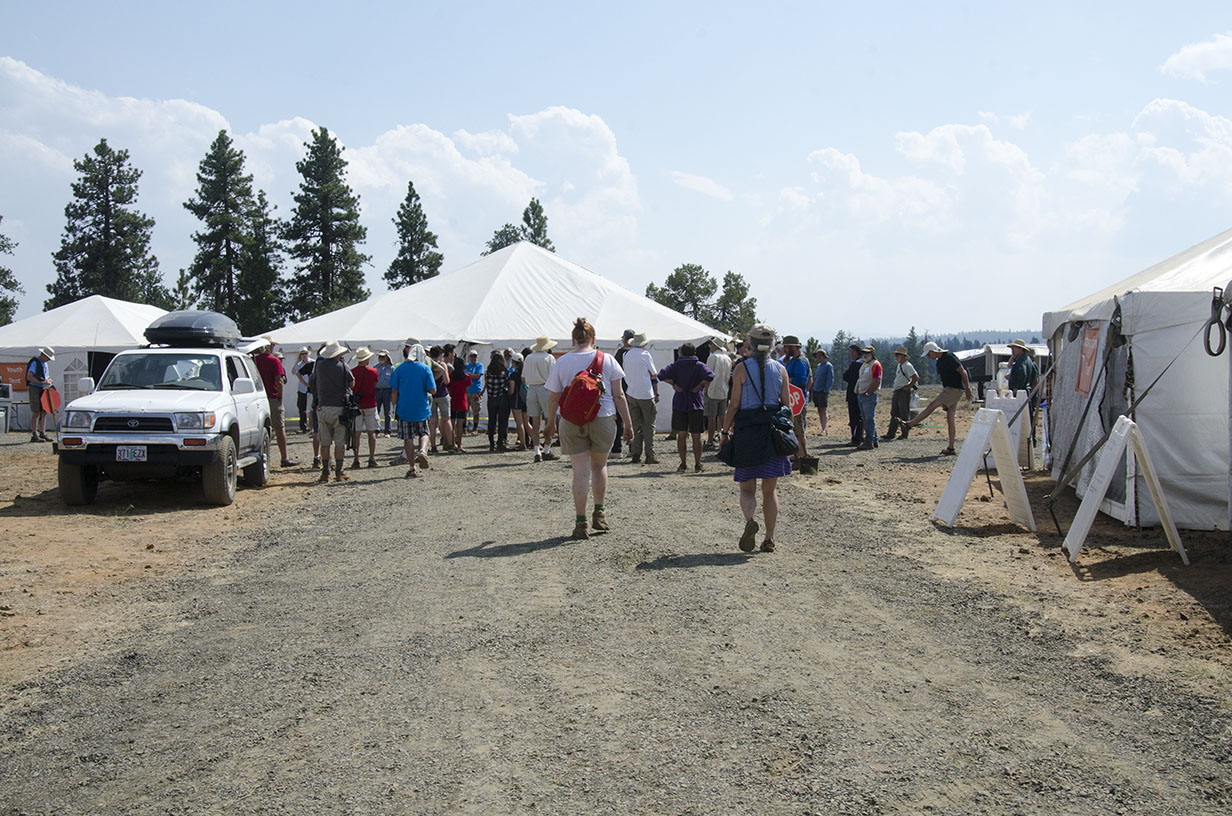
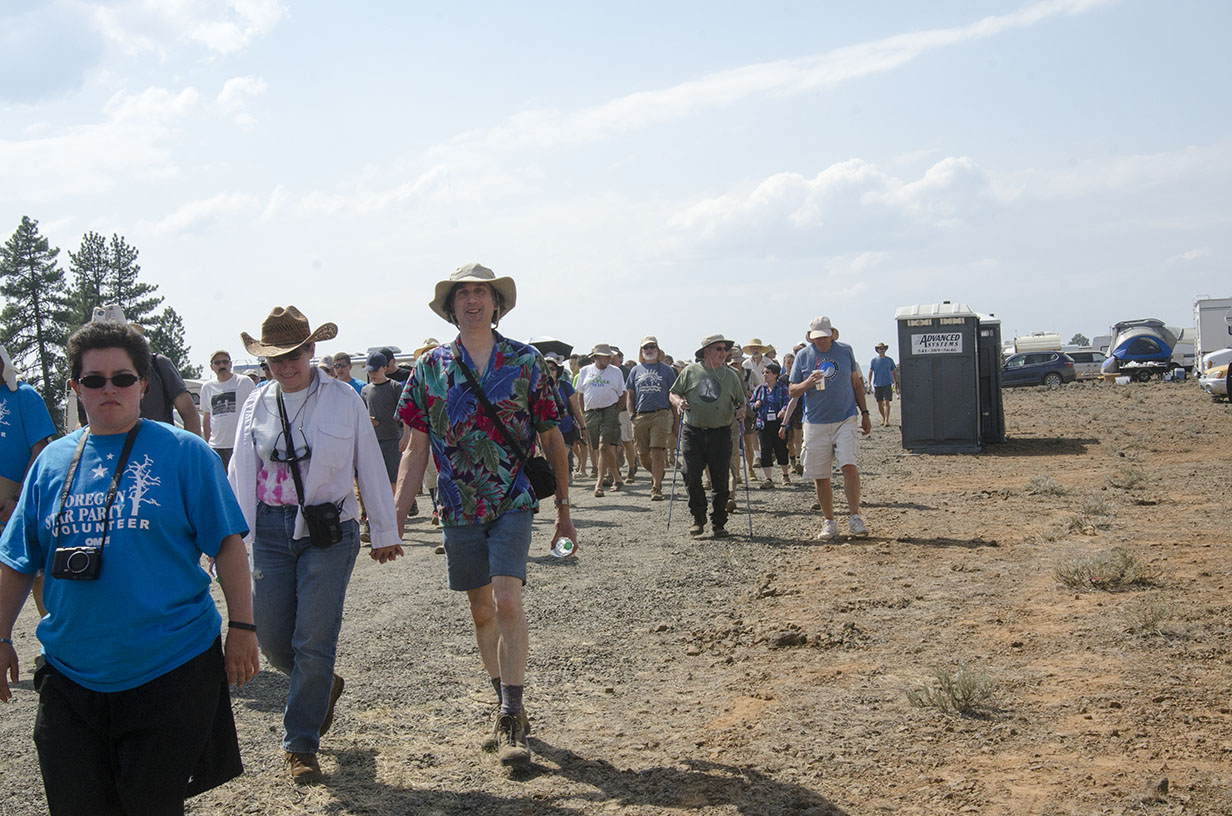
Scott Lee's 14 inch [36cm] Newtonian, in fine Oregon Star Party Telescope Walkabout tradition, was finished two days before the star party began. The tube assembly consists of two parts, the bottom mirror portion and the upper tube end, held together by a square middle ring. The upper end rotates for comfortable eyepiece angle and lifts out for transport. The scope uses a Hubble Optics primary. Note the duct tape, a telescope maker's friend.

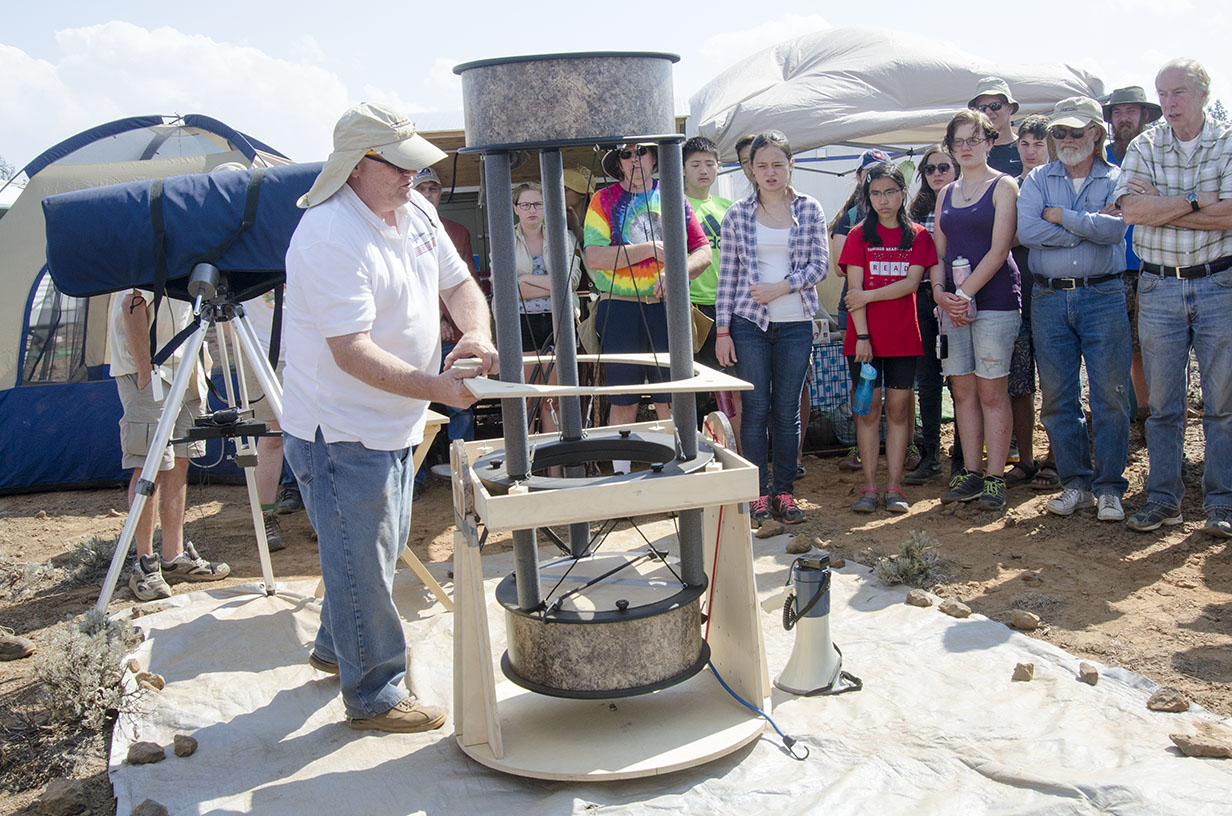
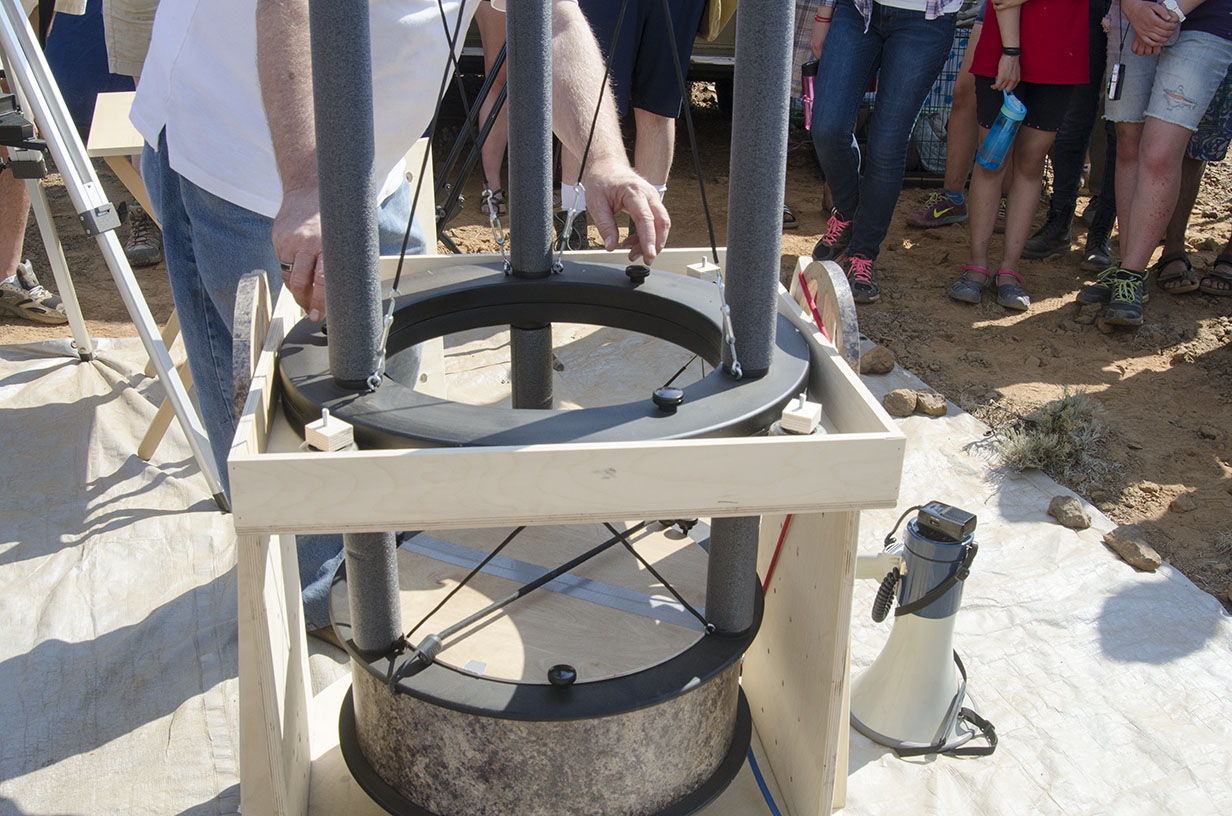
Bill Faatz, A.K.A. "Mr. Bill" on the CloudyNights forum, displayed an impressive 5 inch [13cm] binocular telescope nicknamed the "Star Sweeper" dedicated to E.E. Barnard, arguably the greatest visual observer of all time. The light collected by the iStar F5.5 lenses is reflected by three mirrors such that the interpupillary distance is adjustable. He used Mel Bartels' diagonal calculator for each of the three diagonal mirrors to maintain 72% edge of field illumination. Bill reports that the light drop-off is not apparent in the eyepieces. Bill uses 24mm PanOptic eyepieces that yield unobstructed views at 29x with a 2.3 degree FOV and a 4.4mm exit pupil. Bill says that this is a sweet spot for viewing large scale Milky Way structure that large aperture bino-Dobs cannot match. He also reports that contrast and light transmission of first surface dielectric mirror system is much superior to prisms and avoids problems that porro binoculars seem to have with false pupils and light scatter. Bill collimates by focusing one side, then defocusing the other until the star is a large disk of light. He then collimates using adjustment plates by centering the focused star in the defocused disk. The interpupillary adjustment is easy, however, to focus, the eyepieces must be repositioned in diagonals and locked into position - an approach maybe not public star party friendly. The binocular telescope is altazimuthly mounted on a G11 mount. Bill also built an altazimuth mount for his large 100mm binoculars.

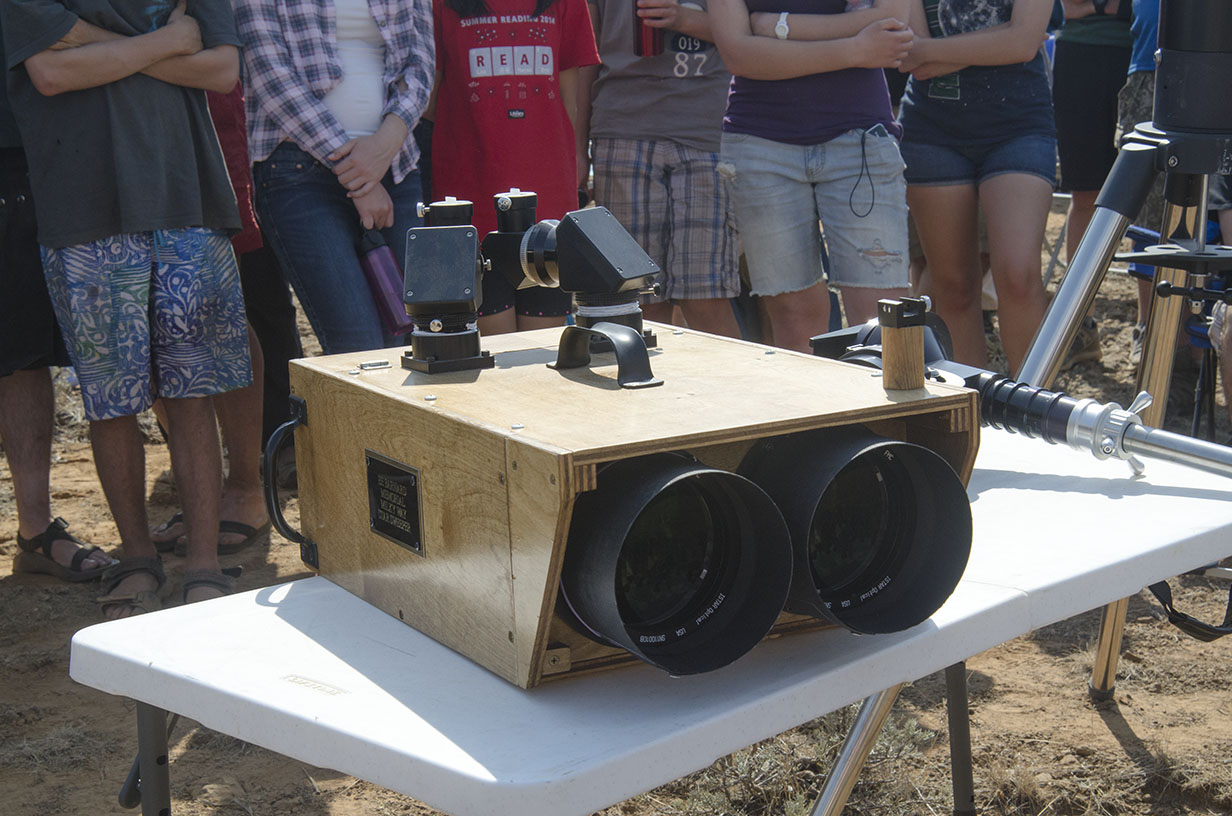
Don Peckham has invented a new string telescope, the Tensegrity telescope. Buckminster Fuller coined the term, Tensegrity, which stands for Tension Integrity. Don says that the tubes are under compression and the strings are under tension. The tubes and strings meet at common corners so there is no torque or twisting to the mirror box or upper end as can be the case with string telescopes. Consequently the mirror box can be lighter. The poles are rather flimsy tent poles made by a shop in the Portland area while you wait. The result is an incredibly lightweight tube structure that is unbelievably strong. Key is the string and pole skirt that does not touch the compression tubes holding the upper end away from the mirror box. The strings form wide angles, several times stronger than a string scope. It is as if the mirror box is four feet wide. And the strings are under a fraction of the tension of a string scope. In fact, the strings need just enough tension so that they do not sag. Don uses a Sidereal Technology drive system with timing belt drives which are quite accurate. For more see his Tensegrity telescope page.
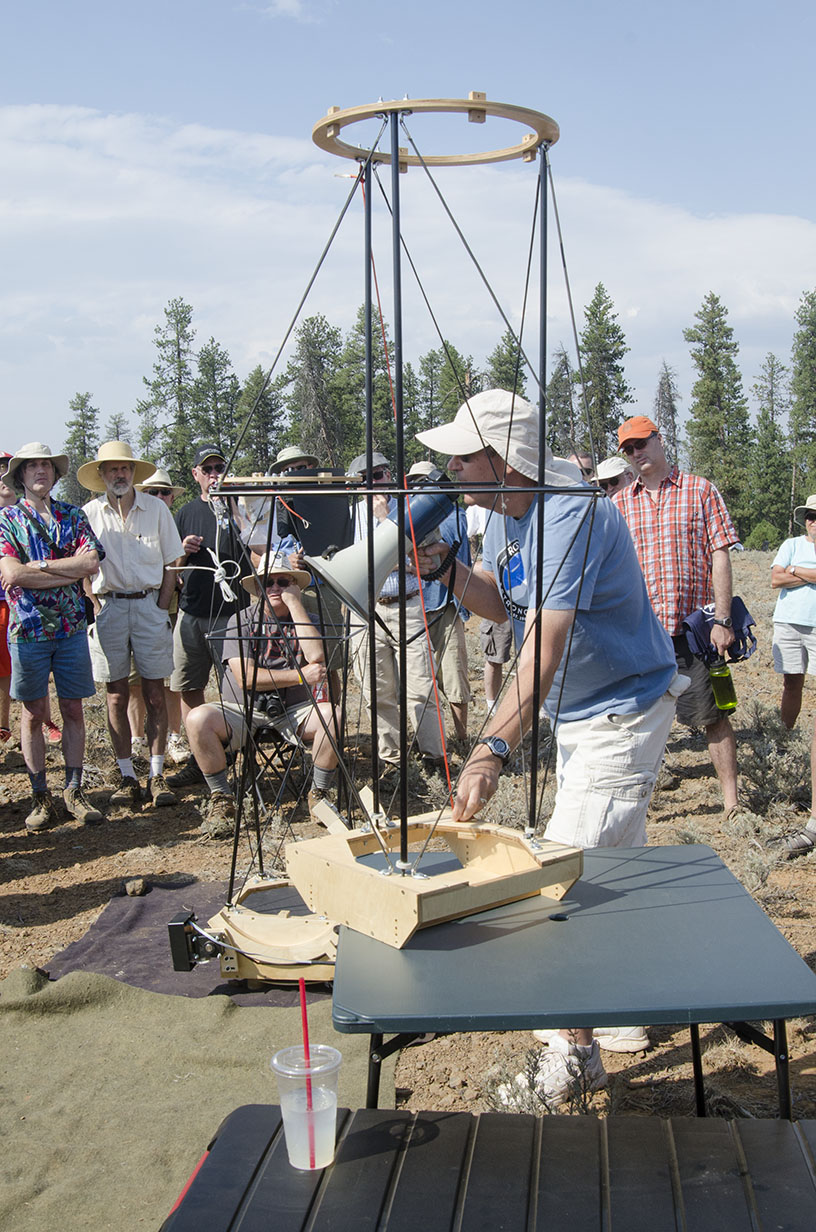

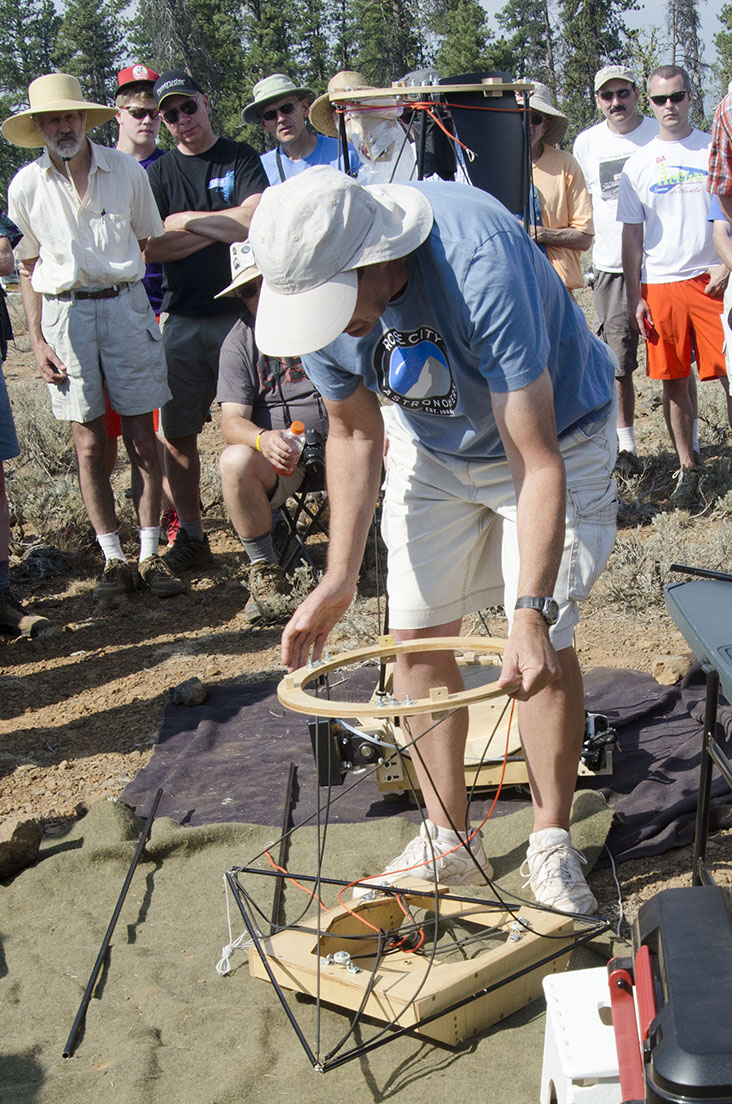
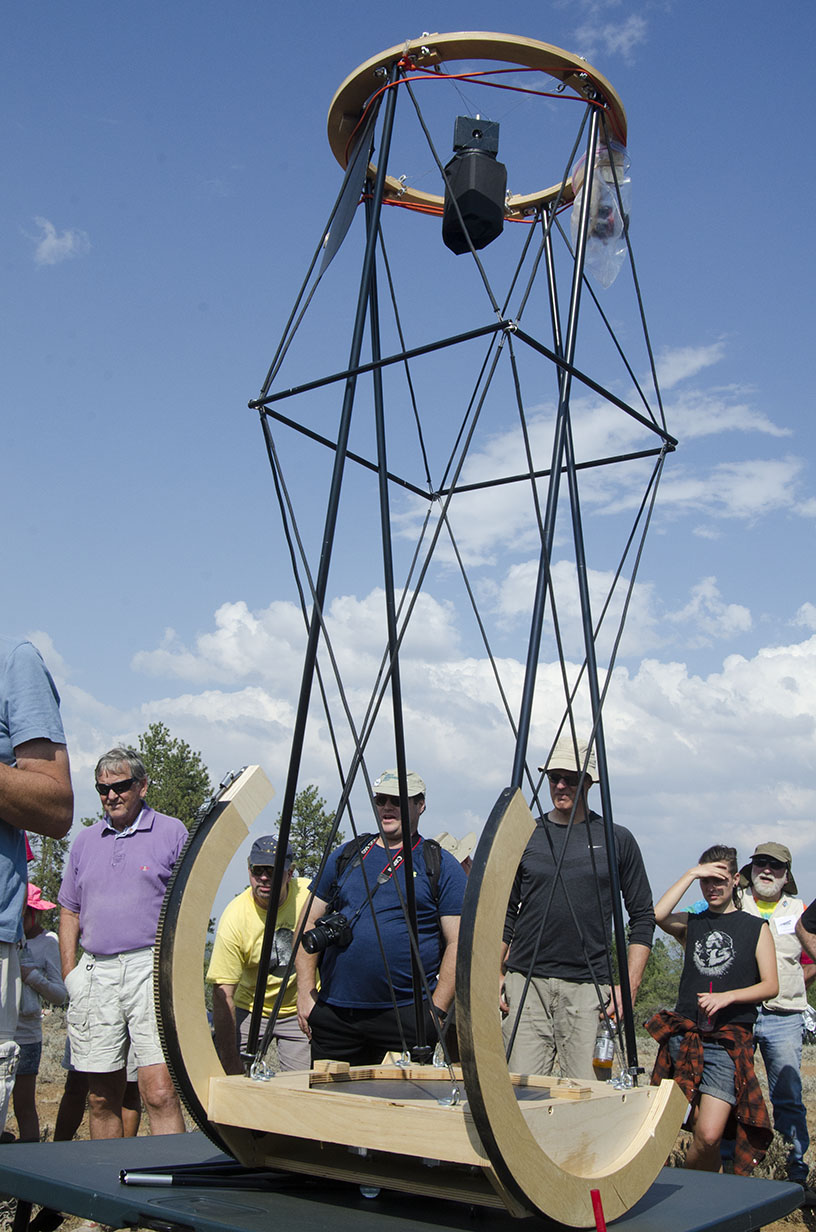
Rob Brown showed a Mark III sun bucket solar scope. Rob, for whom Rob's Tree or more precisely, Rob's Stump, is named for, wanted a perfectly safe white light solar scope. There is no access to the eyepiece, no way to hurt oneself either by looking at the Sun or by sticking a hand into the beam which is only concentrated at the eyepiece. The view is projected from a Celestron C8 Schmidt-Cassegrain onto a white metal screen, which is viewed by a reflecting front surface mirror. I got a chance to look - it's a surprisingly detailed view. Some discussion ensued on eyepieces to use. Rob says that the main factor to look for is a metal field stop. A plastic one might melt if the Sun is off-centered. Rob uses a novel low height equatorial table. His Mark I model was a 60mm scope and the Mark II projected the image from a C8 into a Home Depot bucket.
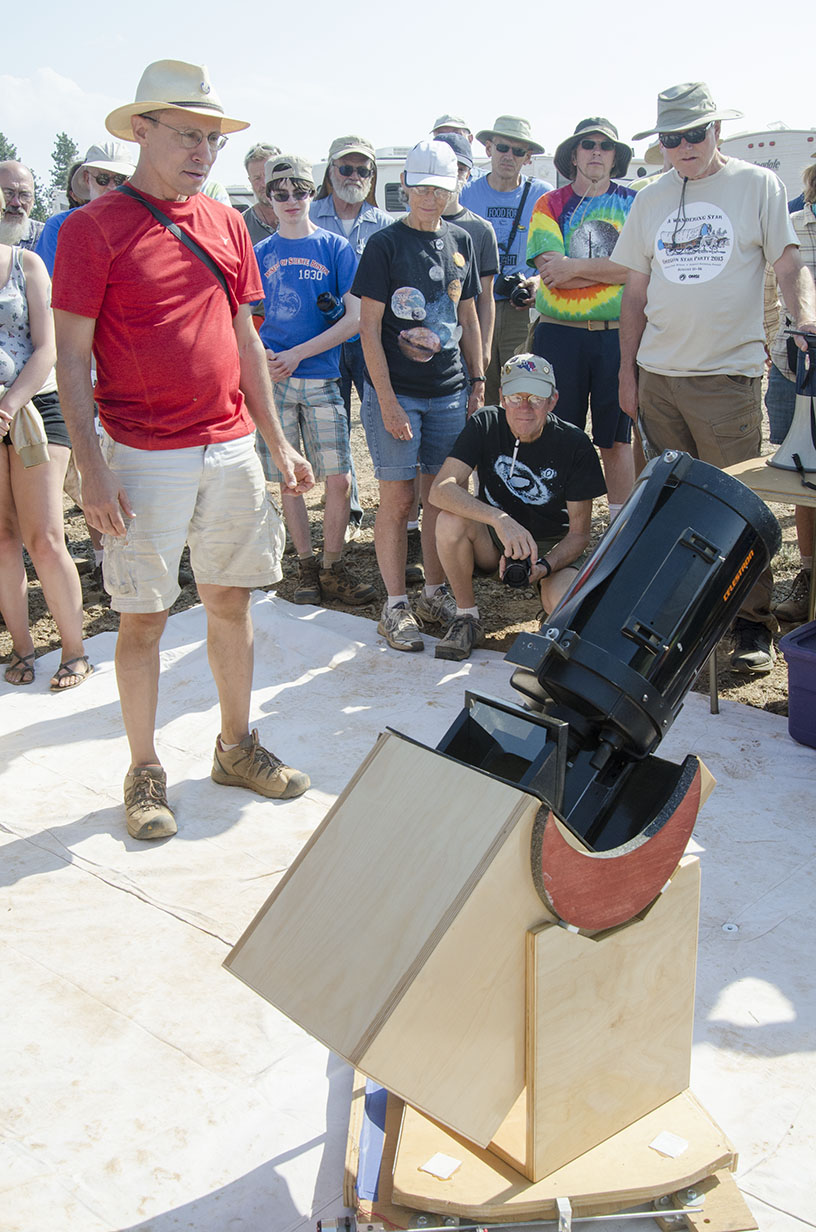
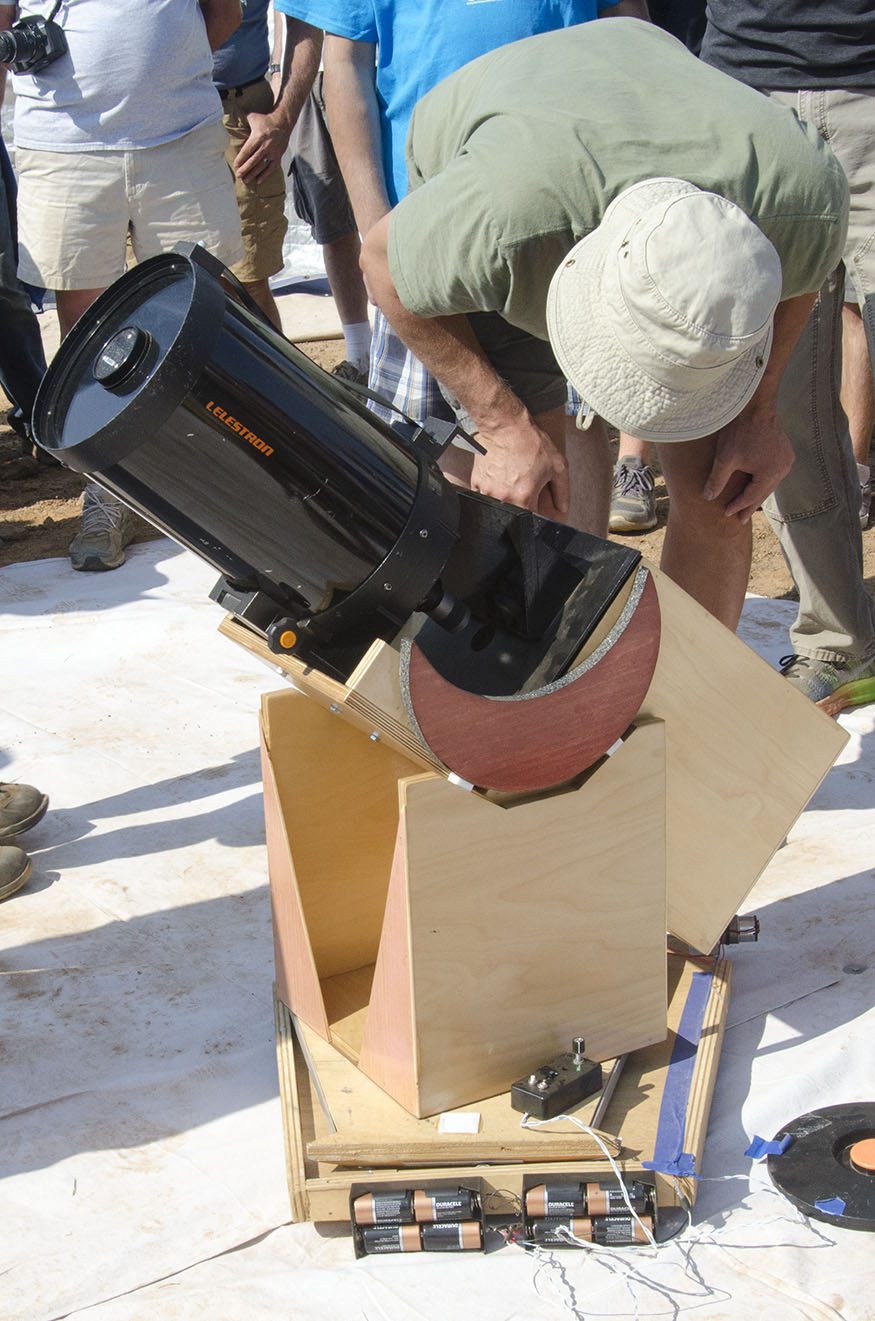
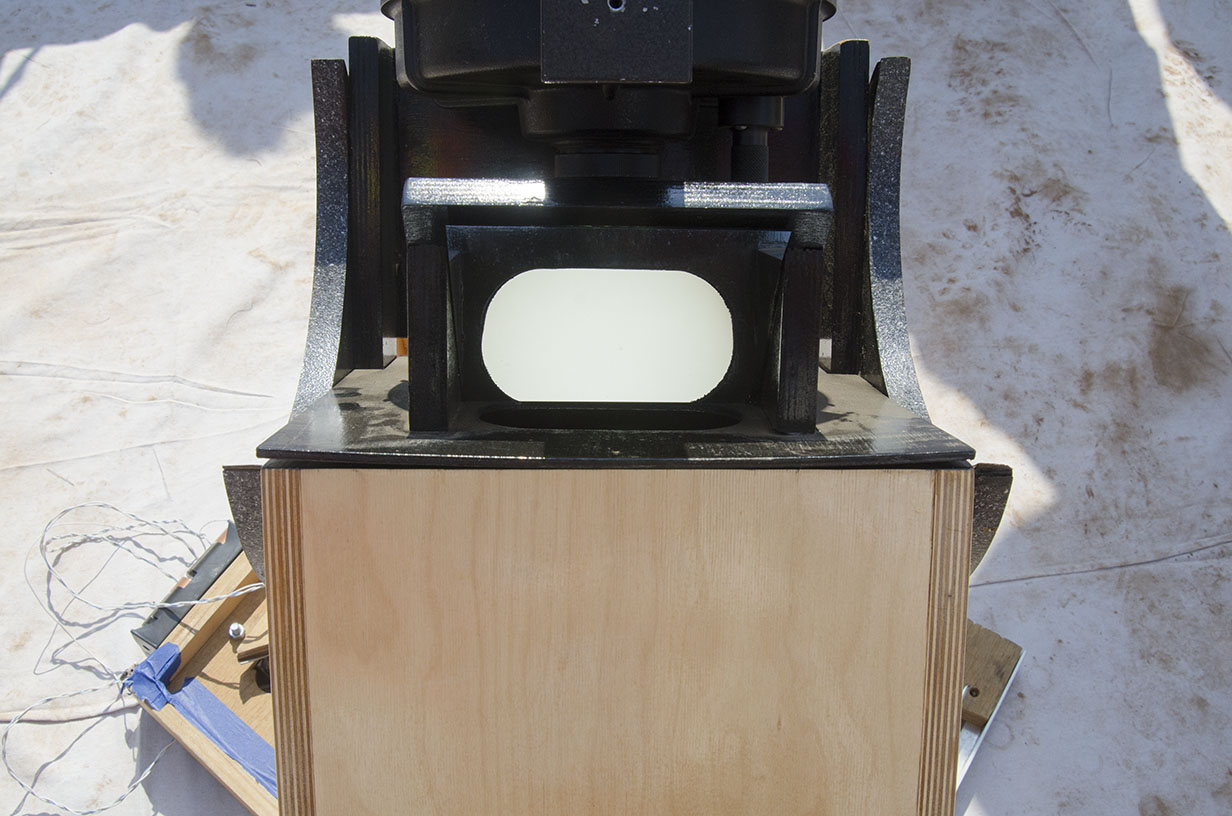
Greg Rohde's 16 inch [41cm] telescope features the Sidereal Technology drive system entirely inboard, incased within the base of the telescope. There are no ankle busting motors or gear boxes protruding from the side of rocker base. The telescope's motions are entirely ball bearings with the clutches supplying the stiction at the eyepiece. There is no Teflon. The drive train consists of servo motors with 10:1 planetary reducers. The drive wheels are covered with Velcro hook material that grabs Velcro felt drive surfaces. Greg reports no slippage while slewing and smooth tracking. He uses 10k encoders to report the telescope's axes angles. The cables go through the azimuth's center tapered roller bearing. For transport the altitude arms fold down on top of the base.
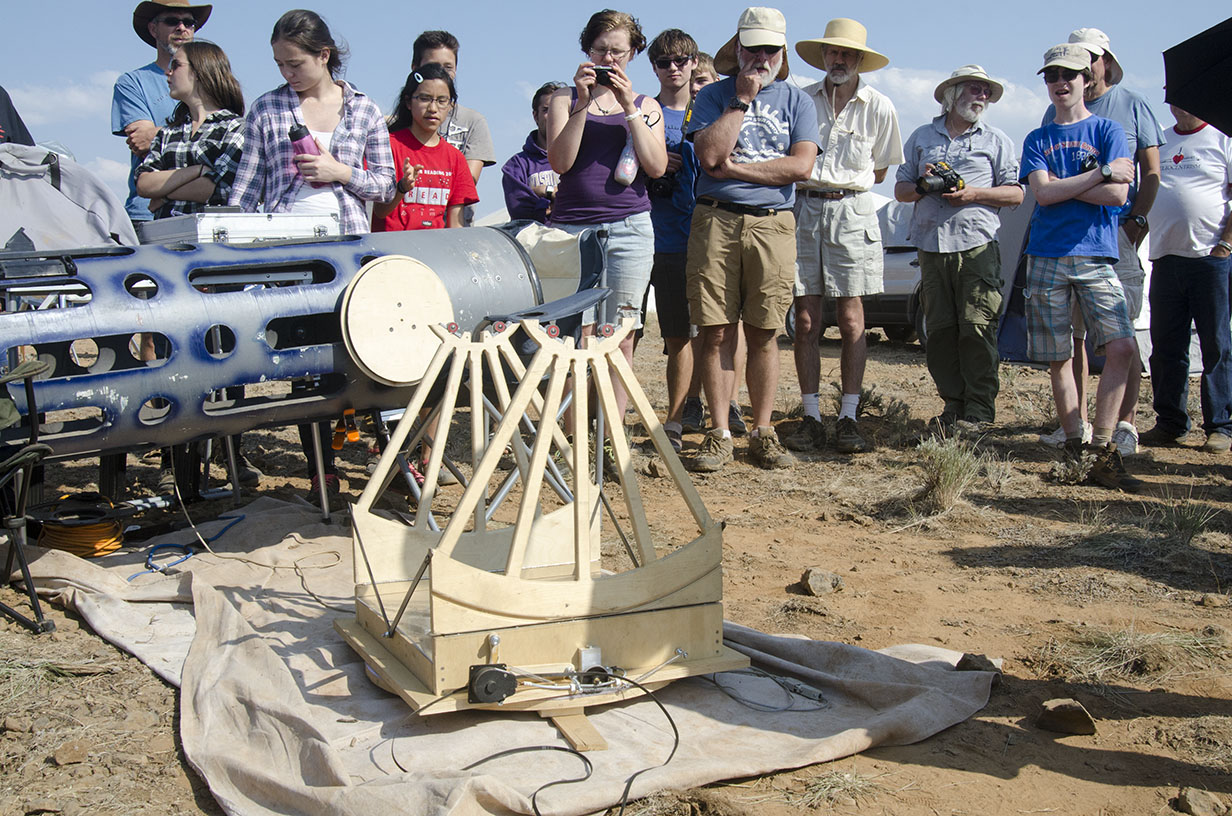
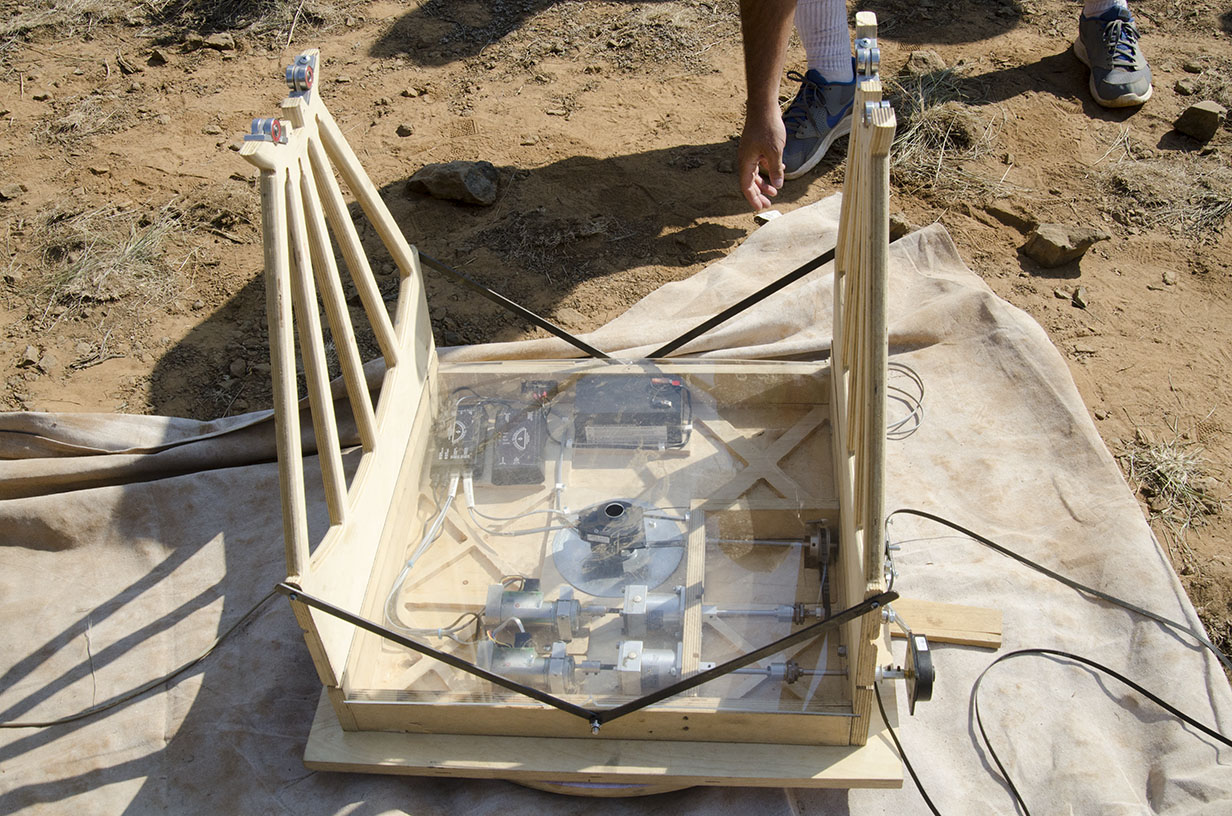

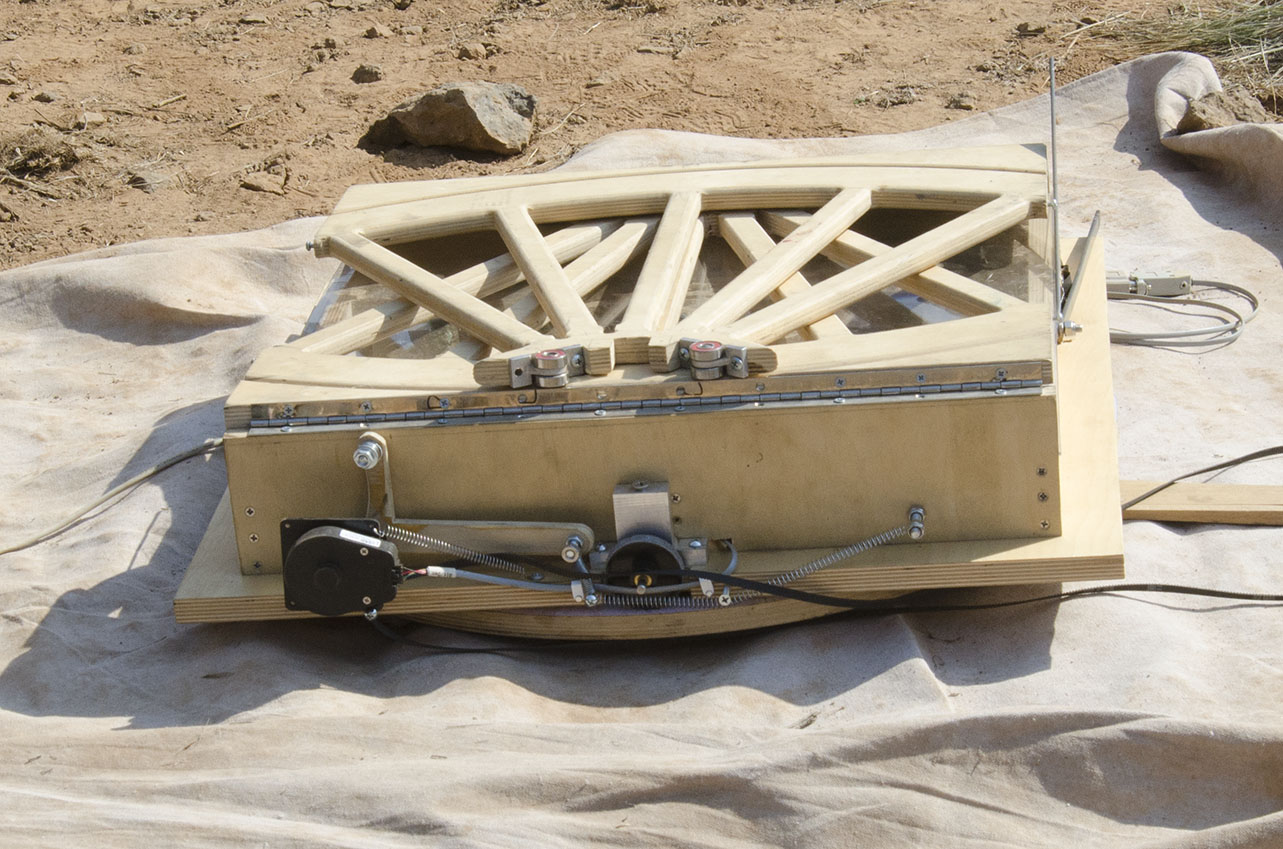
Jerry Oltion's bolt on equatorial table was designed to minimize the height of the table and to utilize the existing base of the 20.5 inch [52cm]. Jerry reduced the equatorial table to a flat 'T' piece of plywood, two bolt on arcs faced with aluminum and a bolted on pivot for the northern bearing point. The table provides 55 minutes of tracking time and is reset by lifting one corner and sliding the scope back to its starting position. A very small motor powered by a modest battery pack that lasts for many nights is sufficient to power the table's tracking. The southern side's arcs can be intimidating to calculate and make. Jerry hung the mount in his shop, pivoting it on the bearing point, to use a sander to shape the arcs. This results in an accurate curve. Proof is in the tracking at 500x. Objects stay centered with no drift and no jitter. The tracking system materially helped Jerry in his successful quest to bag the notorious 'Level III' Oregon Star Party observing list, with many of the objects demanding very high magnification and involved star hops. Jerry took care to modify the existing flex rocker so that the moving parts Center of Gravity is centered on the polar axis as delineated by the north polar bearing point. As an additional bonus, Jerry's 12 inch binocular scope uses the same base so can be used with equatorial table tracking too.
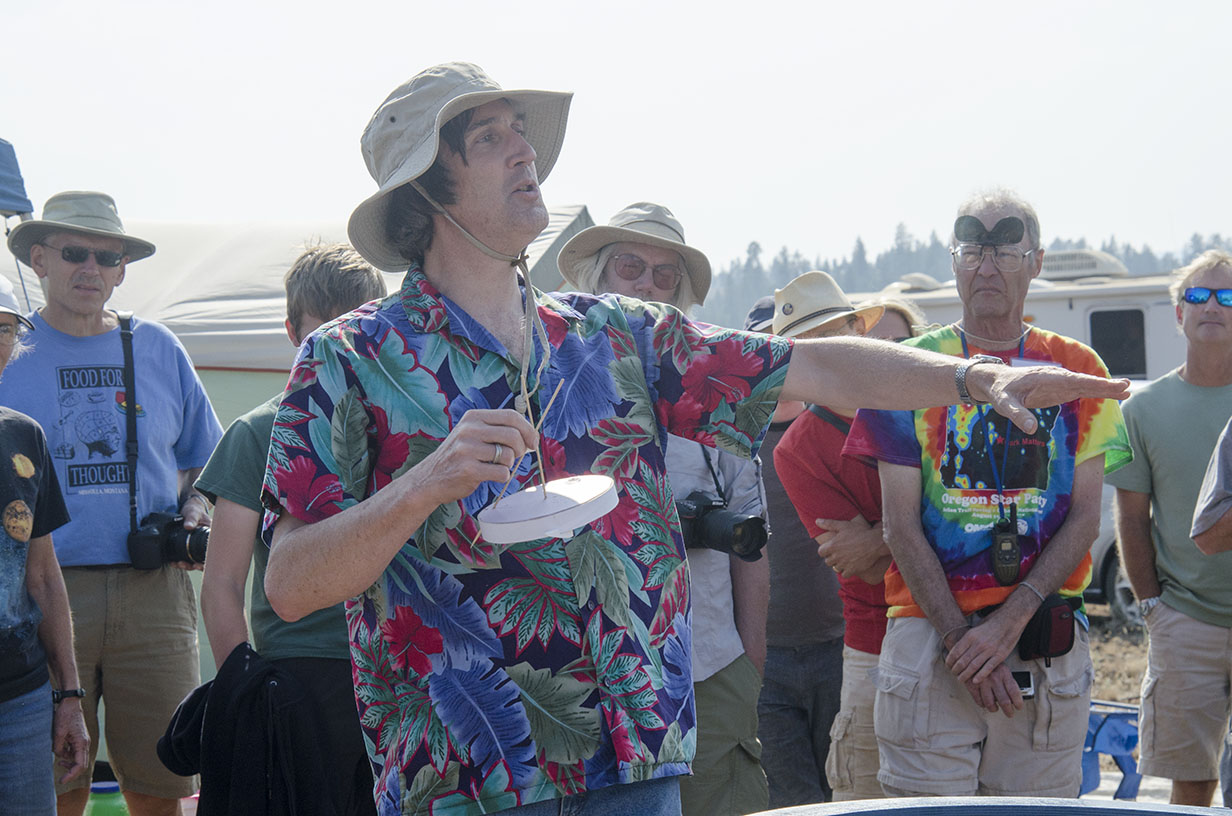
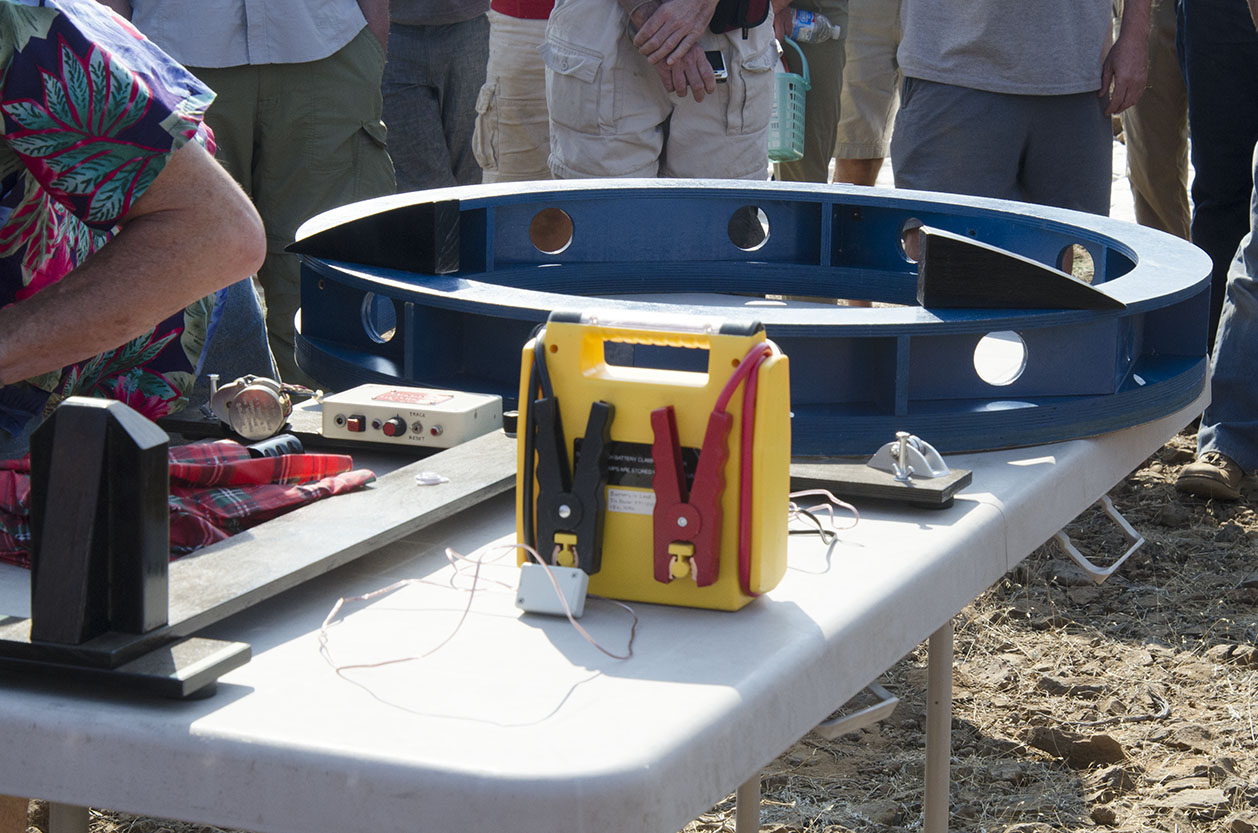
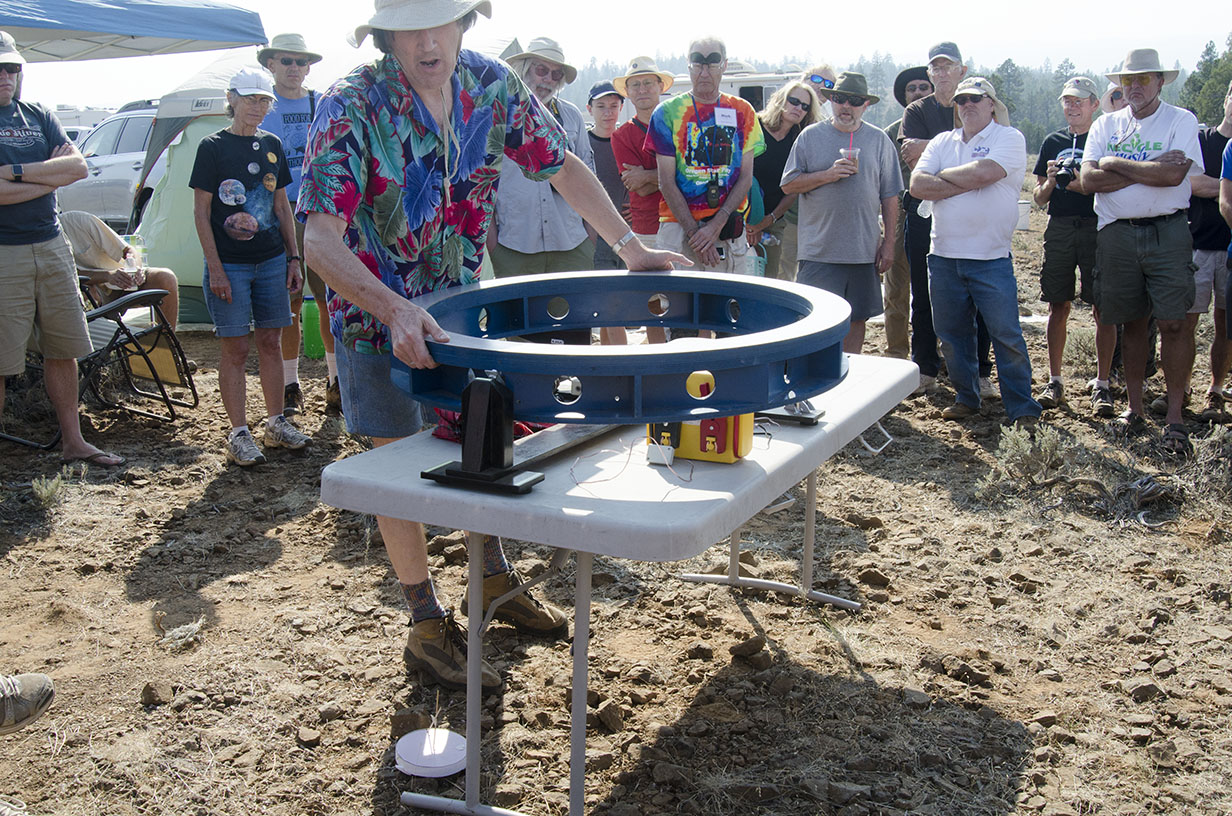

Hitoshi Yokoyama traveled from Japan to present his 76mm binocular reflecting telescope. A novel blend of re-purposed and altered parts, Hitoshi began with two popular small aperture 'Cosmos Kids' reflecting telescopes, known commercially as Skywatcher Infinity 76 or 76P Deluxe telescopes. These scopes have a 280mm focal length and are F3.7; the mirrors are quite good. He uses 16mm Nagler eyepieces that give a 4.7 degree field of view at 18x. Since the mirror diameter is 76mm and his eye spacing is 65mm, Hitoshi cut back the edge of each mirror with a diamond cutter, taking three hours each, so that the mirrors mate up against each other to adjust the interpupillary distance with a slider. The telescope base comes from a buoy found at the beach. The binocular scope weighs 11 pounds [5kg]. Look closely for the red box at the binoscope's side. It's a Theremin (think classic science fiction movie music)! For more see Hitoshi's webpage.
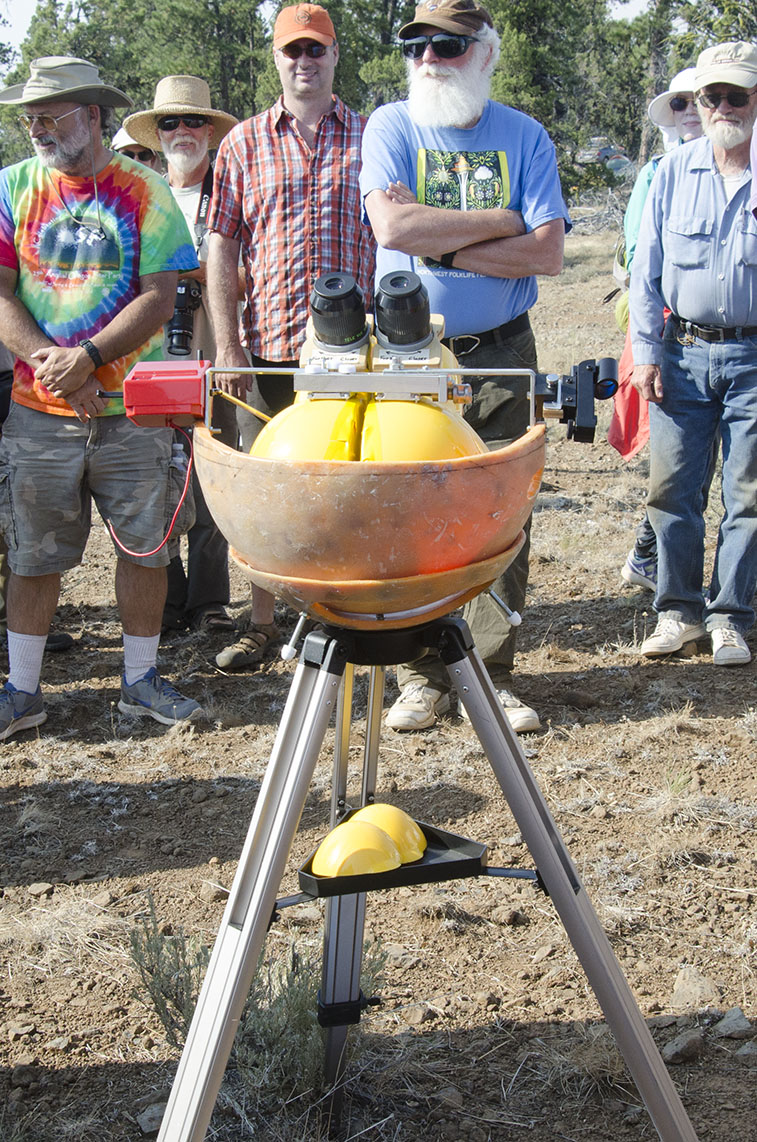
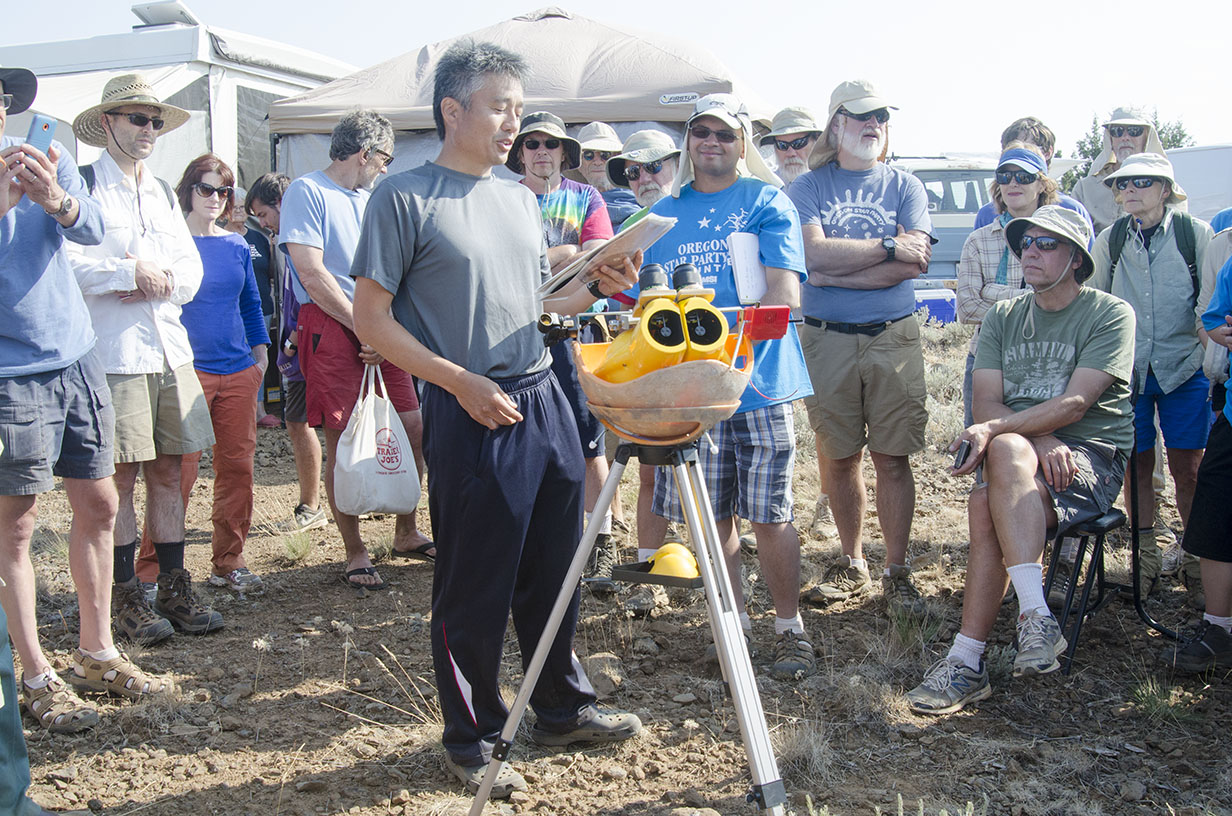

Frank Szczepanski's unequal large aperture binocular telescope is unique. One side is a 12 inch [30cm] and the other side a 10 inch [25cm]. The focal lengths match to 2.5%, more than the recommended 1.5% allowed variance. A number of us viewed through the scope and found no problems with the 2.5% difference. The views through the telescope with both eyes are significantly better than the view through either the 12 inch or 10 inch sides, indicating that the binocular effect is working. This is surprising because the views through the 12 inch and 10 inch side look different to the eyes and have different exit pupils. This begs the interesting question, "How much aperture is needed to trigger the binocular effect?" Would an 8 inch coupled to a 12 inch be sufficient? How about a 6 inch? Per the design that Frank has perfected with his binocular telescopes, knobs within reach of the eyepiece adjust alignment and interpupillary distance. He uses slide focusers. Frank was also trying out a large lensed zero power finder by Chuck, known for developing the split pupil finder. The equal binocular telescope came about when Frank tragically dropped one of the 15 inch mirrors that he was grinding for a large aperture binocular. He looked about for two mirrors of similar focal length that could be combined and hit upon the idea of experimenting with unequal apertures.
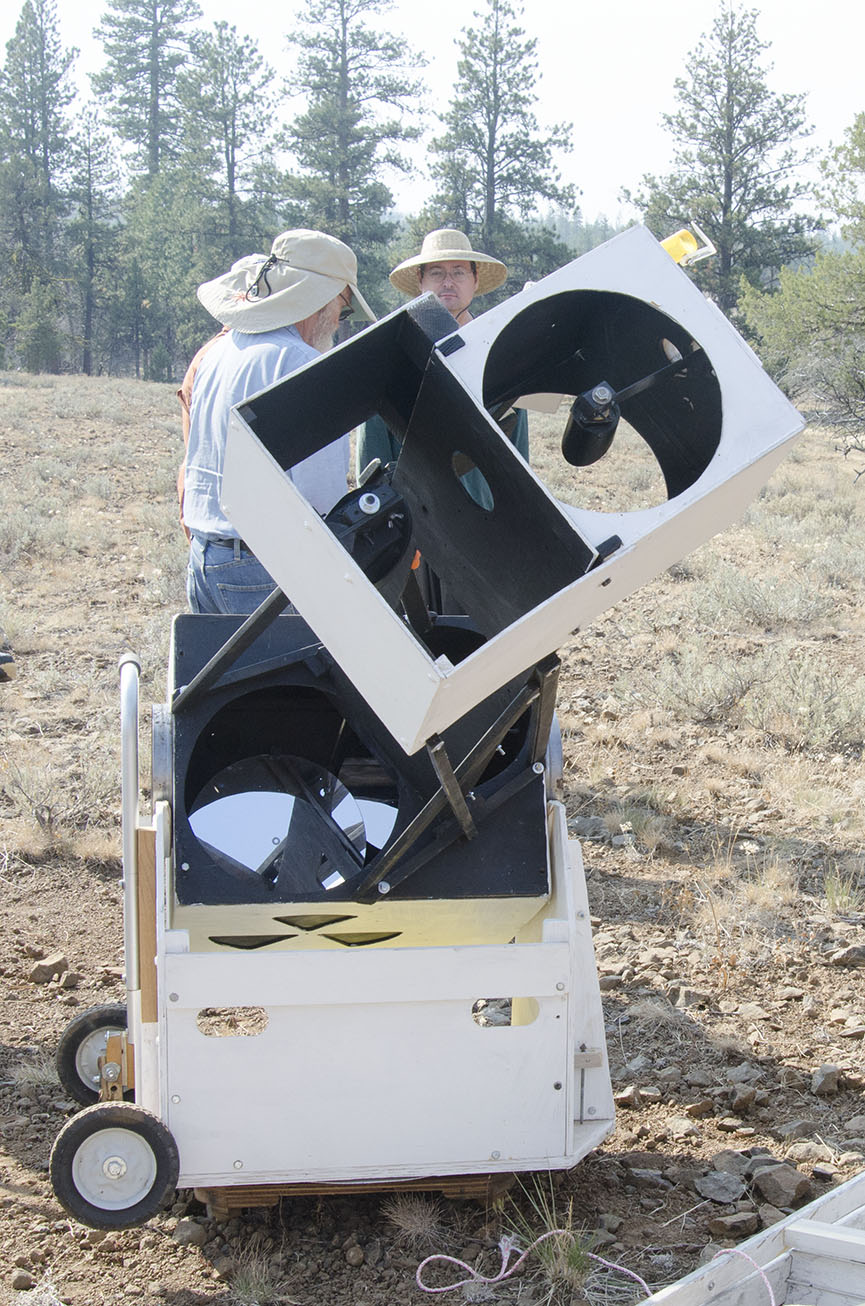
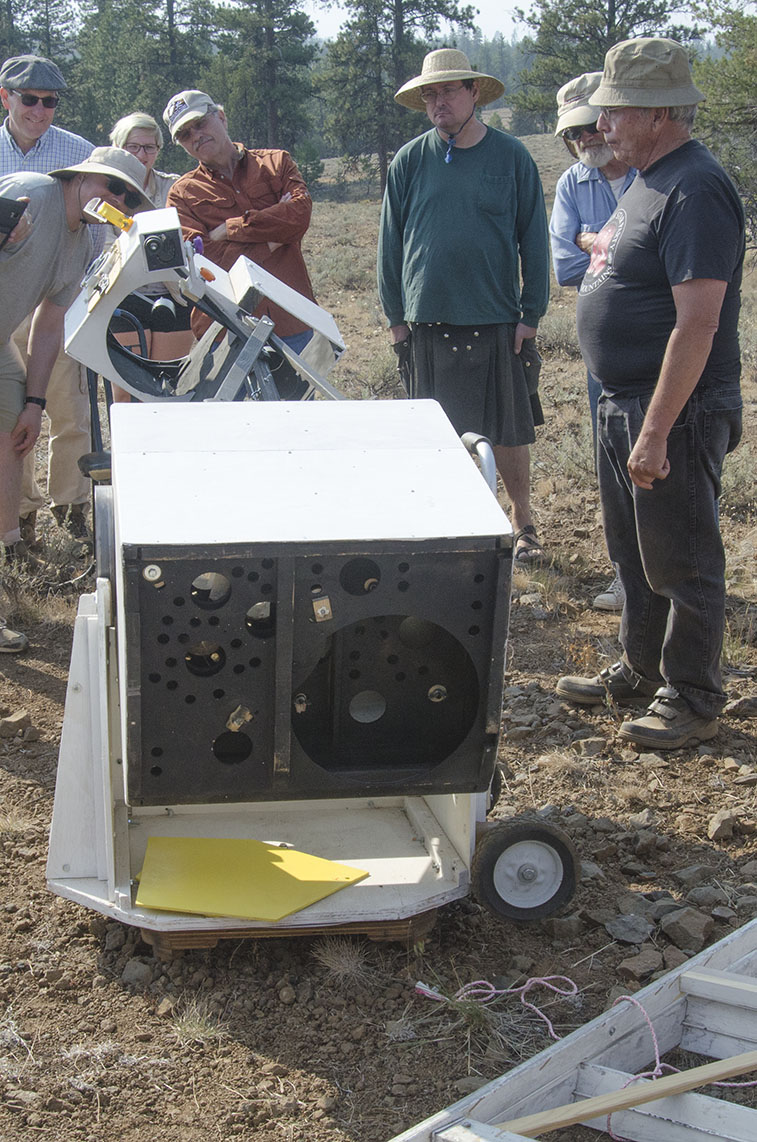
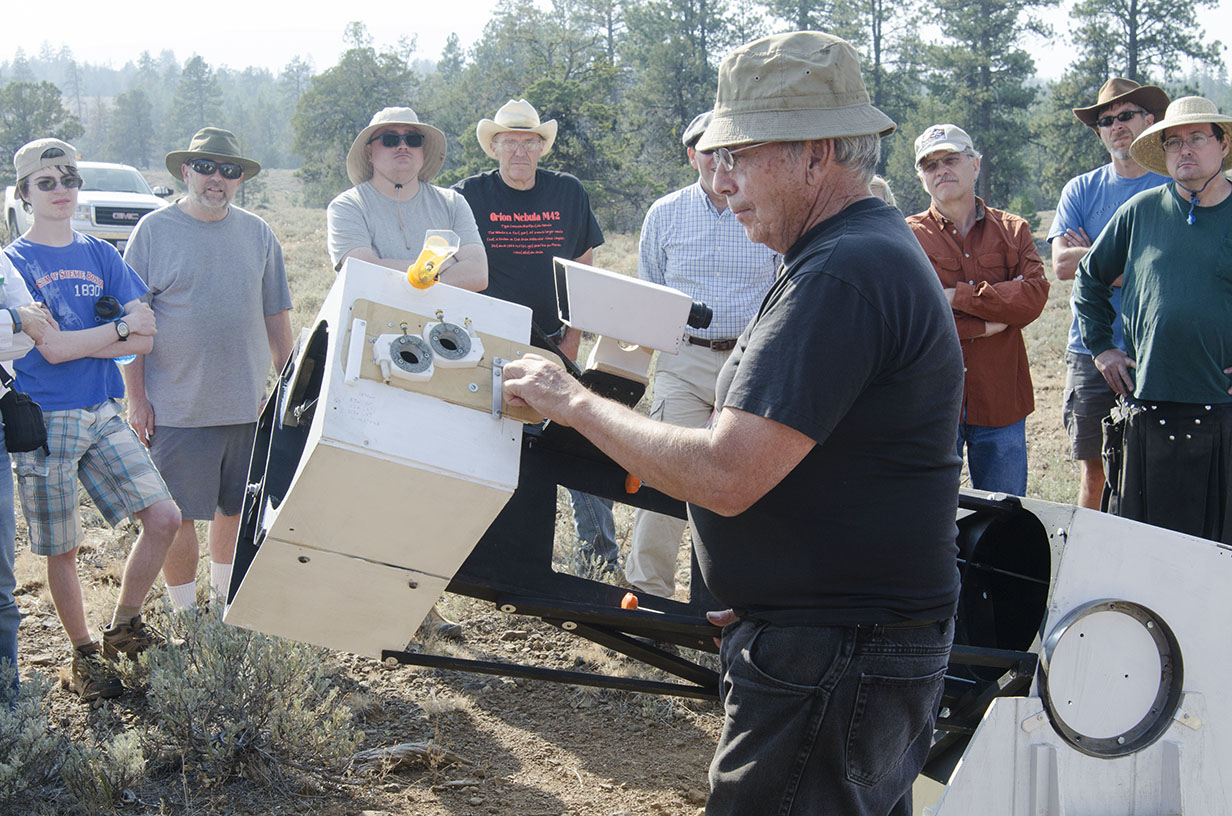
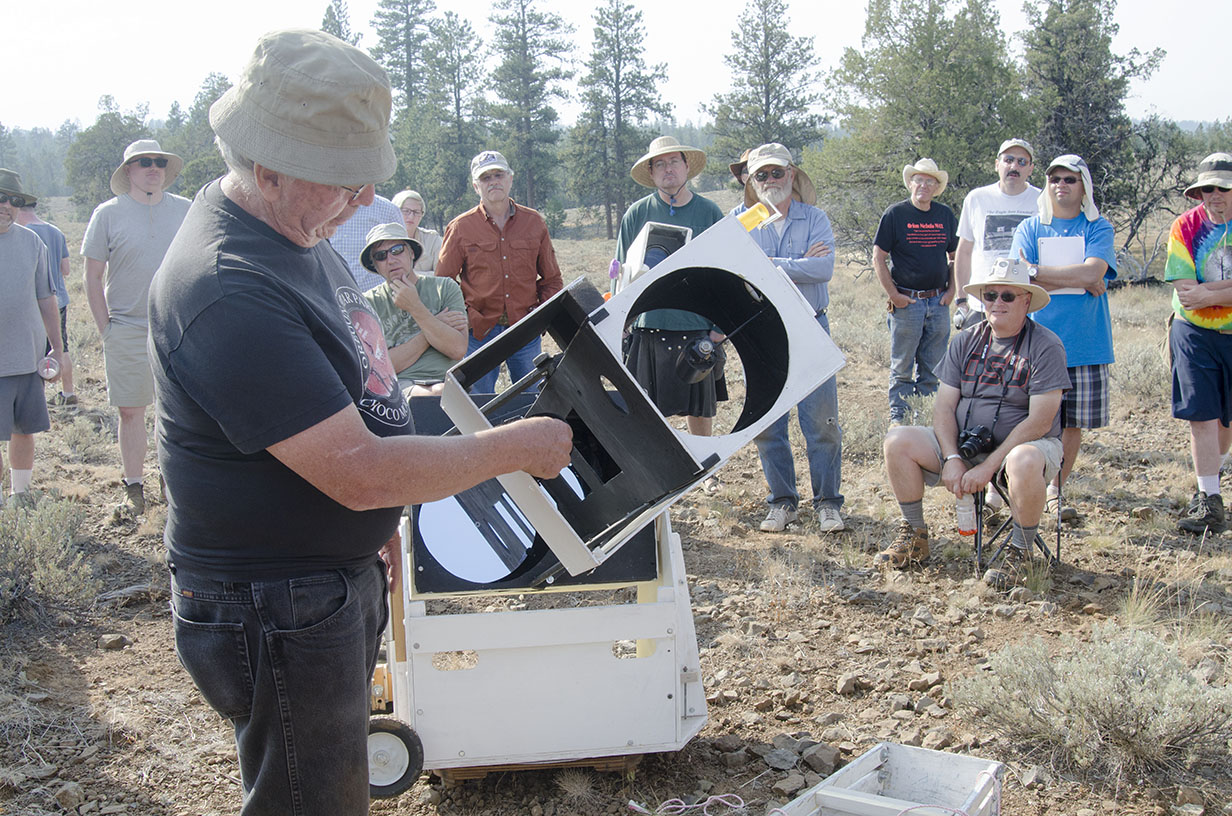
See you all next year!